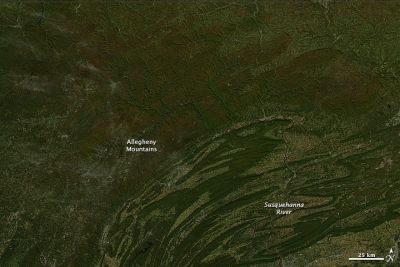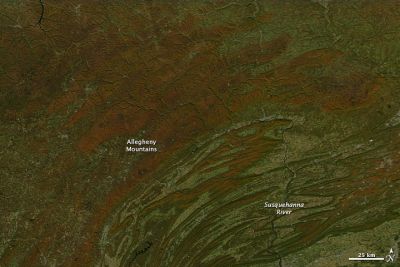An idiosyncratic sampling of the latest science papers. Forthwith: Oil and ducks don’t mix (at least for 25 years); Globalism is bad for the global economy; What color should we paint the wind turbine, honey? Plus, bonus autumn photos.
- A long-term study of the effects of the 1989 Exxon Valdez oil spill on harlequin ducks supports a growing consensus that the cumulative mortality associated with chronic exposure to residual oil may exceed the acute mortality in the days and weeks immediately following a spill. Directly after the Exxon Valdez disaster, harlequin duck numbers declined 25 percent in oiled areas, survival rates remained depressed 6 to 9 years afterward, and did not match survival rates from unoiled areas for at least 11 to 14 years. The researchers project a timeline to complete recovery of 24 years, with a range of 16 to 32 years for best- and worst-case scenarios. The harlequin duck study is one of the most thorough considerations of the consequences of a major oil spill ever undertaken. The paper: Harlequin Duck population injury and recovery dynamics following the 1989 Exxon Valdez oil spill. Ecological Applications. 20:1993–2006. DOI:10.1890/09-1398.1.
 Harlequin duck. Credit: Dick Daniels, courtesy Wikimedia Commons.
Harlequin duck. Credit: Dick Daniels, courtesy Wikimedia Commons.
-
Today’s globalization makes the world economy more sensitive to recession and more resistant to recovery from recession than it was 40 years ago. A team of physicists analyzed UN trade data of the past 40 years. Using evolutionary theory, they predicted an increasingly sluggish response to recession as trade globalization grew. Their model also accurately predicted an increase in the hierarchical structure of the global trade network for a few years following a recession. The trend held true for three major recessions and four minor ones over the past four decades. The paper: Structure and response in the world trade network. Physical Review Letters. In press.
 Credit: Dorothea Lange, courtesy Wikimedia Commons.
Credit: Dorothea Lange, courtesy Wikimedia Commons.
-
Wind turbines might be good for tackling climate change, but they exacerbate the other major global change underway—the loss of biodiversity—since turbines kill wildlife, notably birds and bats. Now a team of researchers has assessed whether or not the color of the turbines attracts insects, and therefore insectivorous birds and bats. The common turbine colors ‘pure white’ (RAL 9010) and ‘light grey’ (RAL 7035) were among those found to attract significantly more insects than other colors tested. So, change the color, power down the lethal factor? Seems worth a try. The paper: Insect attraction to wind turbines: does colour play a role? European Journal of Wildlife Research. DOI: 10.1007/s10344-010-0432-7.
 Wind turbine. Photo courtesy Wikimedia Commons.
Wind turbine. Photo courtesy Wikimedia Commons.
- Plus, summer turned to brilliant autumn in only five days in the Allegheny Mountains last week. According to Holli Riebeek, who captioned the Earth Observatory page:
Fall color typically peaks in mid-October as leaves gradually lose chlorophyll during the lengthening fall nights. Chlorophyll colors leaves green, so as the concentration of the pigment fades, so too does the leaves’ green color. Other pigments—carotenoids (yellow, orange, and brown) and anthocyanins (red and purple)—can then show their colors.
Here’s how it looked from space, as green forests with a hint of orange (first image) turned pure orange (second image) five days later:
 Mountains and highlands of northern Pennsylvania, 8 October 2010. Credit: NASA images courtesy Jeff Schmaltz, MODIS Rapid Response Team at NASA GSFC.
Mountains and highlands of northern Pennsylvania, 8 October 2010. Credit: NASA images courtesy Jeff Schmaltz, MODIS Rapid Response Team at NASA GSFC.
 Mountains and highlands of northern Pennsylvania, 13 October 2010. Credit: NASA images courtesy Jeff Schmaltz, MODIS Rapid Response Team at NASA GSFC.
Mountains and highlands of northern Pennsylvania, 13 October 2010. Credit: NASA images courtesy Jeff Schmaltz, MODIS Rapid Response Team at NASA GSFC.












